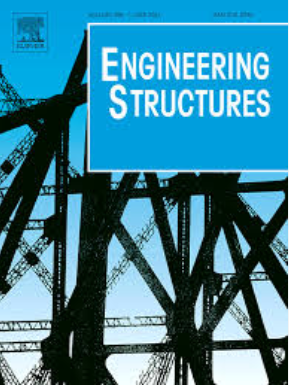Performance enhancement of low-prestressed self-centering braces: An experimental study
IF 5.6
1区 工程技术
Q1 ENGINEERING, CIVIL
引用次数: 0
Abstract
Self-centering (SC) braces have demonstrated efficacy in controlling structural peak and residual deformations after earthquakes; however, their widespread adoption has been obstructed by high prestressing force demands. To address this limitation, a Low-Prestressed Self-Centering (LPSC) brace was developed, featuring a tension-only energy-dissipative system formed by integrating a ratchet component and steel dissipators in series. This configuration minimizes resistance to self-centering system during brace unloading, enabling effective self-centering under low prestress. Although the mechanism of this brace has been verified, two critical challenges remain in its seismic performance: limited cumulative energy-dissipative capacity and considerable free-travel (the slip distance required for brace to develop stable stiffness) observed in its hysteresis behavior. This study enhanced the performance of the LPSC brace by conducting elongation tests on steel dissipators and parametric evaluations of the ratchet component, with an emphasis on increasing cumulative energy-dissipative capacity and stabilizing hysteretic behavior. These component-level enhancement were subsequently validated through comprehensive full-scale brace tests. Stainless steel (S31603) was identified as an alternative to conventional Q235 steel for the steel dissipator, with elongation tests demonstrating that S31603 achieves elongation capacities over three times those of Q235 steel. Furthermore, parametric tests on the ratchet component revealed that reducing chuck size and increasing spring prestress effectively minimize free-travel during cyclic loading. Comprehensive full-scale brace tests demonstrated that the enhanced LPSC brace achieves a cumulative energy-dissipative capacity with a twofold increase compared to the original design, with free-travel reduced to 1/4 of the original configuration. These findings confirm that the enhanced LPSC brace addresses critical limitations of earlier designs, offering improved energy dissipation and seismic reliability. The proposed enhancements establish the LPSC brace as a viable and efficient solution for practical applications in resilient structural systems.
提高低预应力自定心支具性能的实验研究
自定心支撑在控制地震后结构峰值和残余变形方面表现出良好的效果;然而,它们的广泛采用受到高预应力要求的阻碍。为了解决这一限制,开发了一种低预应力自定心(LPSC)支撑,其特点是由棘轮组件和钢制减压件串联形成的拉力耗散系统。这种结构最大限度地减少了支撑卸载过程中对自定心系统的阻力,在低预应力下实现了有效的自定心。虽然这种支撑的机制已经得到验证,但其抗震性能仍然存在两个关键挑战:有限的累积能量耗散能力和在其迟滞行为中观察到的相当大的自由行程(支撑发展稳定刚度所需的滑移距离)。本研究通过对钢耗能器进行伸长率测试和棘轮组件的参数评估来增强LPSC支撑的性能,重点是增加累积耗能能力和稳定滞回行为。这些组件级的增强随后通过全面的全尺寸支撑测试进行了验证。不锈钢(S31603)被确定为传统Q235钢的替代材料,延伸率测试表明,S31603的延伸率是Q235钢的三倍以上。此外,棘轮部件的参数测试表明,减小卡盘尺寸和增加弹簧预应力可以有效地减少循环加载过程中的自由行程。全面的全尺寸支撑测试表明,增强的LPSC支撑实现了累积能量耗散能力,与原始设计相比增加了两倍,自由行程减少到原始配置的1/4。这些发现证实,增强型LPSC支撑解决了早期设计的关键限制,提供了更好的能量耗散和抗震可靠性。所提出的改进措施确立了LPSC支撑作为弹性结构系统实际应用的可行和有效的解决方案。
本文章由计算机程序翻译,如有差异,请以英文原文为准。
求助全文
约1分钟内获得全文
求助全文
来源期刊

Engineering Structures
工程技术-工程:土木
CiteScore
10.20
自引率
14.50%
发文量
1385
审稿时长
67 days
期刊介绍:
Engineering Structures provides a forum for a broad blend of scientific and technical papers to reflect the evolving needs of the structural engineering and structural mechanics communities. Particularly welcome are contributions dealing with applications of structural engineering and mechanics principles in all areas of technology. The journal aspires to a broad and integrated coverage of the effects of dynamic loadings and of the modelling techniques whereby the structural response to these loadings may be computed.
The scope of Engineering Structures encompasses, but is not restricted to, the following areas: infrastructure engineering; earthquake engineering; structure-fluid-soil interaction; wind engineering; fire engineering; blast engineering; structural reliability/stability; life assessment/integrity; structural health monitoring; multi-hazard engineering; structural dynamics; optimization; expert systems; experimental modelling; performance-based design; multiscale analysis; value engineering.
Topics of interest include: tall buildings; innovative structures; environmentally responsive structures; bridges; stadiums; commercial and public buildings; transmission towers; television and telecommunication masts; foldable structures; cooling towers; plates and shells; suspension structures; protective structures; smart structures; nuclear reactors; dams; pressure vessels; pipelines; tunnels.
Engineering Structures also publishes review articles, short communications and discussions, book reviews, and a diary on international events related to any aspect of structural engineering.
 求助内容:
求助内容: 应助结果提醒方式:
应助结果提醒方式:


